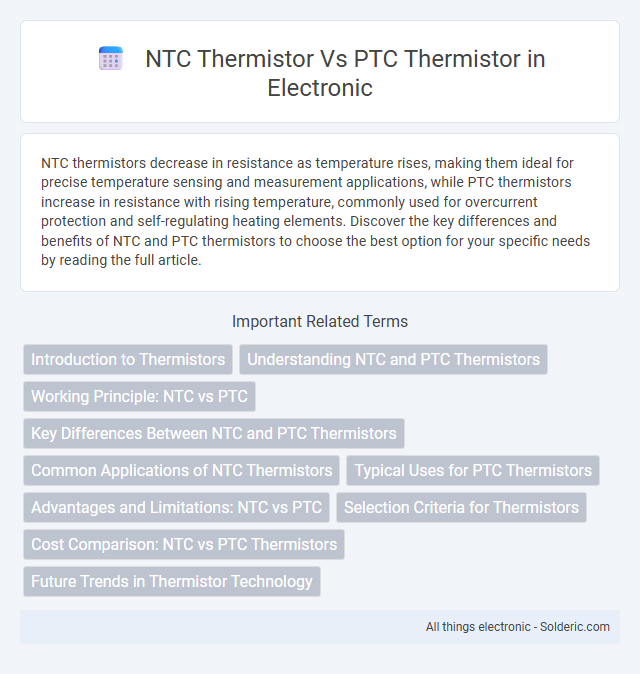NTC thermistors decrease in resistance as temperature rises, making them ideal for precise temperature sensing and measurement applications, while PTC thermistors increase in resistance with rising temperature, commonly used for overcurrent protection and self-regulating heating elements. Discover the key differences and benefits of NTC and PTC thermistors to choose the best option for your specific needs by reading the full article.
Comparison Table
| Feature | NTC Thermistor | PTC Thermistor |
|---|---|---|
| Full Name | Negative Temperature Coefficient Thermistor | Positive Temperature Coefficient Thermistor |
| Resistance Behavior | Resistance decreases as temperature rises | Resistance increases as temperature rises |
| Typical Materials | Manganese, cobalt, nickel oxides | Barium titanate ceramics |
| Temperature Range | -55degC to 125degC (commonly) | -55degC to 150degC (commonly) |
| Applications | Temperature sensing, inrush current limiting, digital thermometers | Overcurrent protection, self-regulating heaters, circuit protection |
| Response Time | Fast response to temperature changes | Slower response compared to NTC |
| Cost | Generally lower cost | Moderate cost |
| Common Use Case | Temperature measurement and compensation | Overcurrent protection and temperature control |
Introduction to Thermistors
NTC thermistors exhibit a negative temperature coefficient, meaning their resistance decreases as temperature rises, making them ideal for temperature sensing and inrush current limiting. PTC thermistors have a positive temperature coefficient, where resistance increases with temperature, commonly used for overcurrent protection and self-regulating heating elements. Both types of thermistors utilize semiconductor materials to provide precise temperature-dependent resistance changes essential for various electronic applications.
Understanding NTC and PTC Thermistors
NTC thermistors decrease resistance as temperature rises, making them ideal for temperature sensing and inrush current limiting applications. PTC thermistors increase resistance with temperature, providing effective overcurrent protection and self-regulating heating elements. Both types utilize temperature-dependent resistance but serve distinct roles in electronic circuits based on their opposite response to temperature changes.
Working Principle: NTC vs PTC
NTC thermistors operate by decreasing their resistance as temperature increases, relying on the negative temperature coefficient property of semiconductor materials. PTC thermistors increase resistance with rising temperature, utilizing the positive temperature coefficient effect caused by polymer or ceramic transitions. This fundamental difference in resistance behavior under temperature changes defines their distinct applications in temperature sensing and circuit protection.
Key Differences Between NTC and PTC Thermistors
NTC thermistors decrease resistance as temperature rises, making them ideal for temperature measurement and inrush current limiting, whereas PTC thermistors increase resistance with temperature, commonly used for overcurrent protection and self-regulating heating. NTC devices typically operate in a negative temperature coefficient range, while PTC thermistors exhibit a positive temperature coefficient near a specific threshold. Understanding these key differences helps you select the appropriate thermistor for precise temperature control or protective applications.
Common Applications of NTC Thermistors
NTC thermistors are widely used in temperature measurement and control applications due to their predictable resistance decrease as temperature rises. Common applications include temperature sensing in HVAC systems, battery management for accurate state-of-charge monitoring, and inrush current limiting in power supplies. Your electronic devices often rely on NTC thermistors for precise temperature regulation and protection against overheating.
Typical Uses for PTC Thermistors
PTC thermistors are commonly used as overcurrent protection devices in electrical circuits, preventing damage by increasing resistance sharply when temperatures rise. They serve as self-regulating heating elements in applications such as electric heaters and automotive seat warmers due to their positive temperature coefficient behavior. Another typical use is in temperature sensing and compensation circuits, where their stable resistance change helps maintain consistent performance in motors and power supplies.
Advantages and Limitations: NTC vs PTC
NTC thermistors offer high sensitivity and quick response to temperature changes, making them ideal for precise temperature measurements, while their limitation lies in a narrow operating temperature range and non-linear resistance. PTC thermistors provide excellent overcurrent protection due to their self-regulating positive temperature coefficient property, with advantages such as durability and resettable protection, but they are less effective in fine temperature measurement because of slower response and higher resistance variation. Choosing between NTC and PTC thermistors depends on the application's need for sensitivity versus protective capability, balancing fast response against reliability under high current or fault conditions.
Selection Criteria for Thermistors
When selecting thermistors, understanding the distinct characteristics of NTC (Negative Temperature Coefficient) and PTC (Positive Temperature Coefficient) types is crucial; NTC thermistors decrease resistance as temperature rises, making them ideal for precise temperature measurements and control. PTC thermistors increase resistance with temperature, providing effective overcurrent protection and self-regulating heating elements. Your choice should align with the application's temperature sensing accuracy, response time, and thermal protection requirements to ensure optimal performance.
Cost Comparison: NTC vs PTC Thermistors
NTC thermistors generally have a lower production cost compared to PTC thermistors due to simpler material compositions and manufacturing processes. PTC thermistors often require specialized polymers or ceramics that increase their overall expense. The cost difference impacts application choices, with NTC thermistors favored for cost-sensitive temperature sensing and PTC thermistors preferred where self-regulating heating or overcurrent protection is needed.
Future Trends in Thermistor Technology
NTC thermistors continue advancing with enhanced sensitivity and miniaturization, enabling more precise temperature measurements in IoT and wearable devices. PTC thermistors are evolving with improved self-regulating heating capabilities, making them ideal for safer overcurrent protection and energy-efficient applications. Your choice between NTC and PTC thermistors will increasingly depend on innovations like nanomaterial integration and smart sensor networks driving future thermal management solutions.
NTC thermistor vs PTC thermistor Infographic

 solderic.com
solderic.com